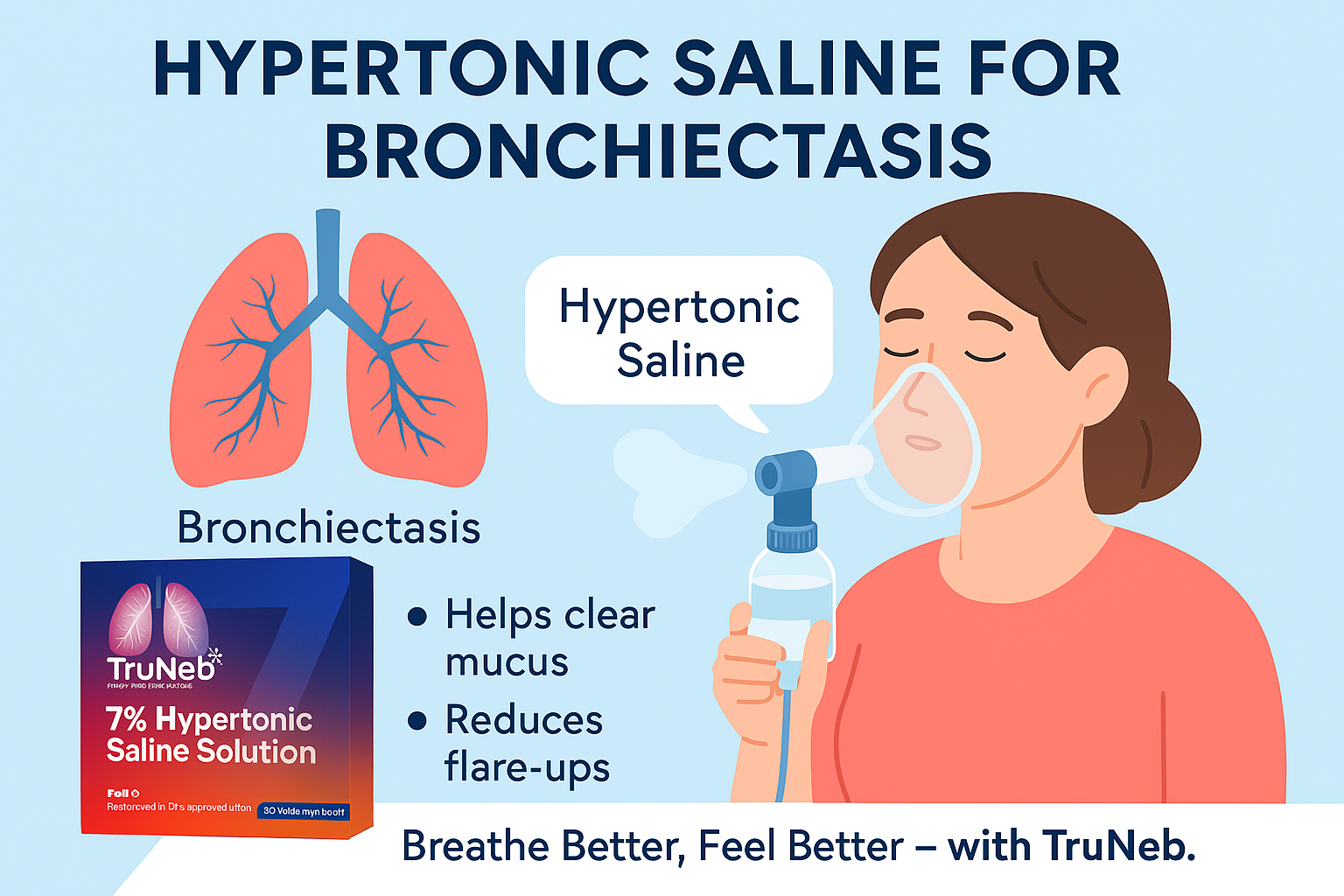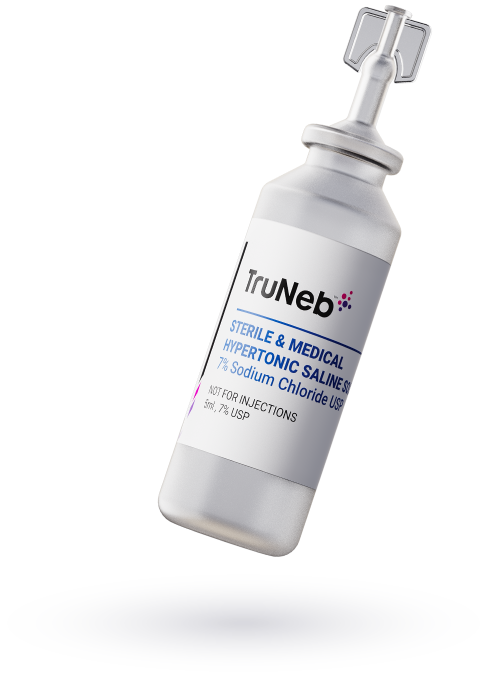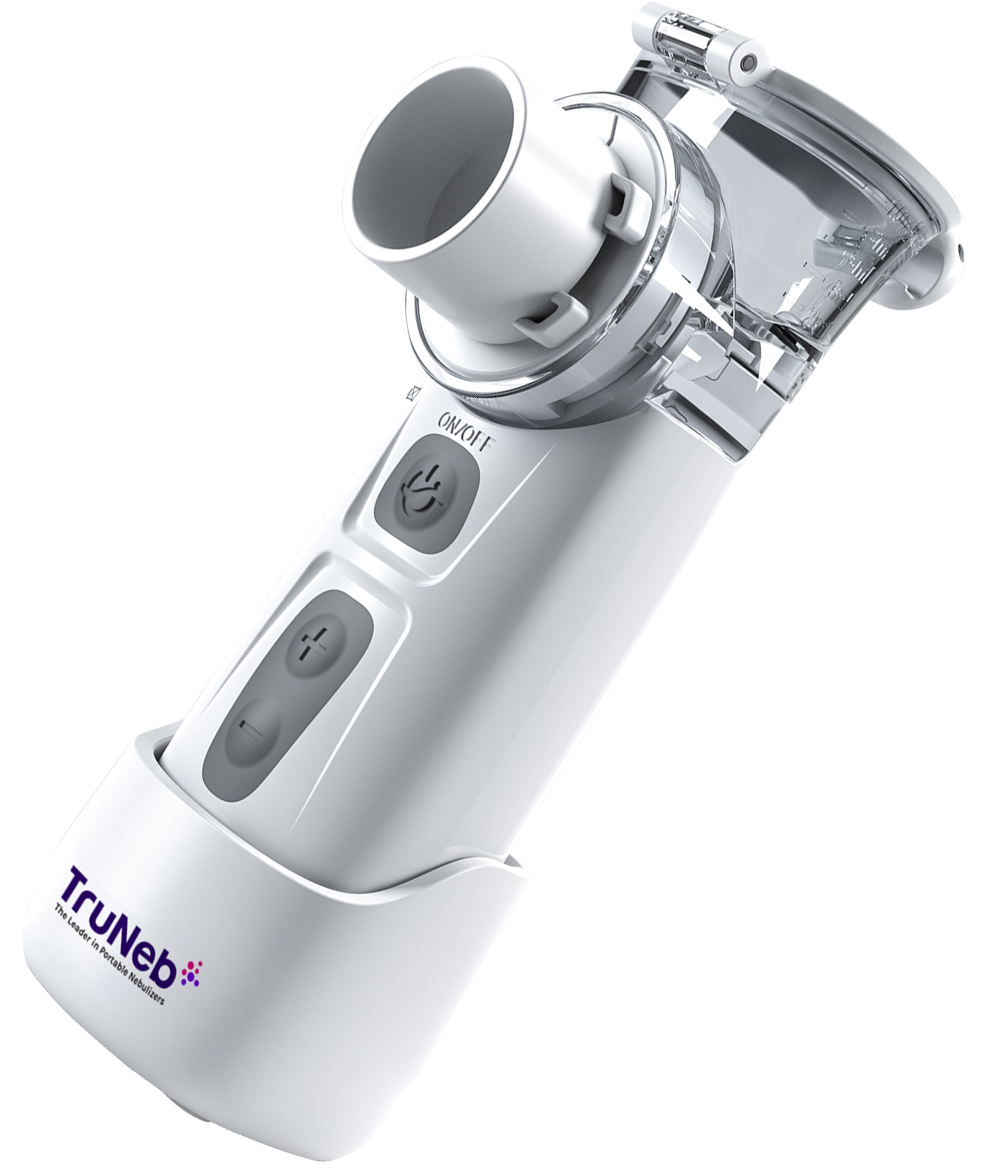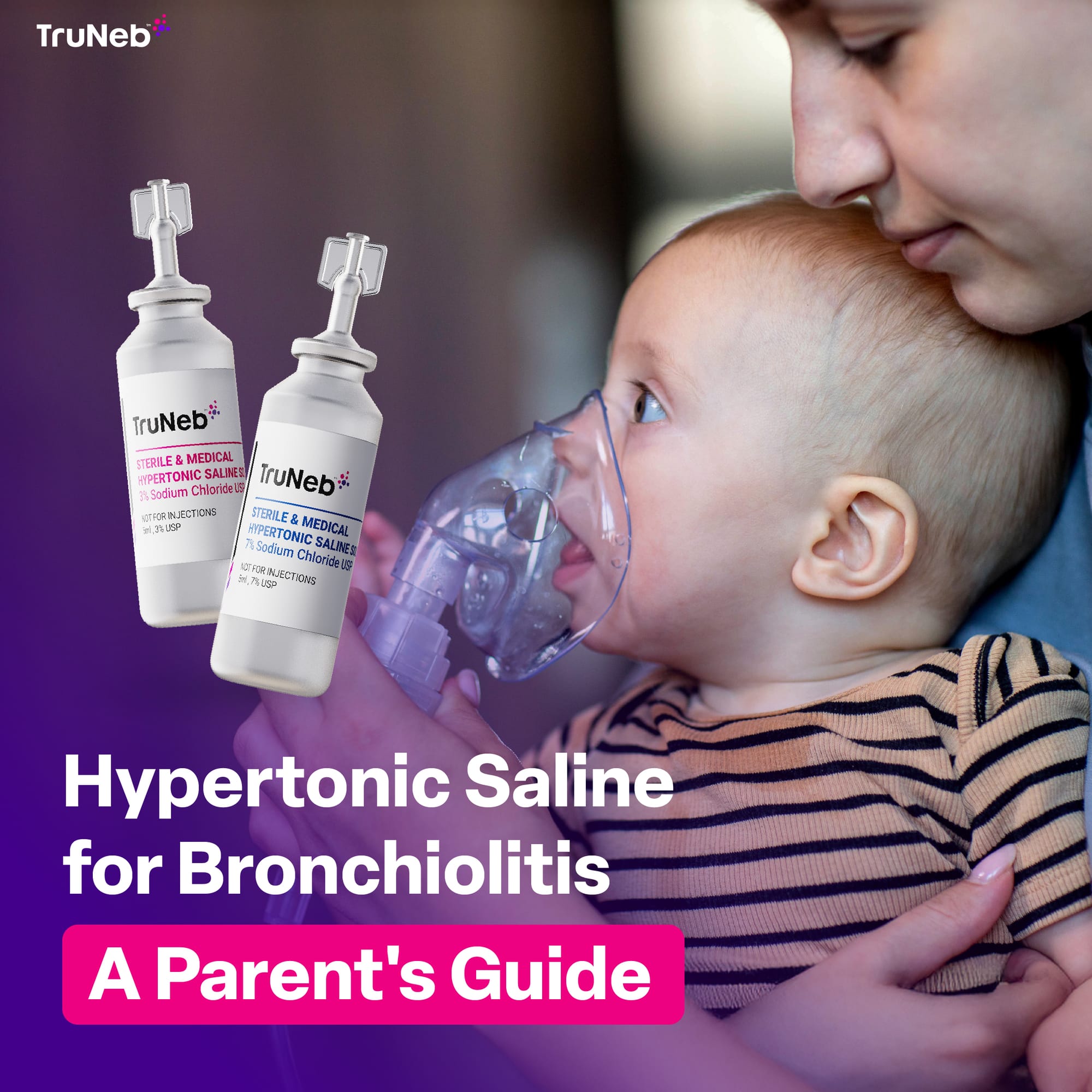On this page

If you live with bronchiectasis, you know how frustrating it can be to constantly deal with mucus that just won't clear. This long-term lung condition causes the airways to become damaged and widened, making it easier for mucus to collect and harder for your lungs to stay clear and free of infection.
One therapy that can help with daily mucus management is hypertonic saline for bronchiectasis via a nebulizer. It’s a simple, drug-free treatment that involves inhaling a salty mist to help loosen mucus and make it easier to cough up.
In this article, we’ll break down how hypertonic saline for bronchiectasis works, when doctors typically recommend it, what benefits you can expect, and how to use it safely and effectively at home.
What Is Bronchiectasis?
Bronchiectasis is a chronic lung condition where the airways (bronchi) become abnormally widened or scarred over time. These changes make it harder for the lungs to clear out mucus, which then builds up and becomes a breeding ground for bacteria.
People with bronchiectasis have side effects like:
- A chronic cough that produces mucus every day
- Frequent lung infections like bronchitis or pneumonia
- Ongoing feelings of chest congestion or shortness of breath
It’s a condition that tends to get worse without proper management, which is why daily mucus clearance is such an important part of treatment.
Why Mucus Buildup Is a Constant Challenge
In healthy lungs, mucus is moved out by tiny hair-like structures called cilia. But in bronchiectasis, those airways are damaged, and the cilia don’t work as well (or at all!)
As a result, mucus sits in the lungs, making it harder to breathe and raising the risk of infection. Over time, this cycle of mucus and infection causes more damage to the lungs. That’s why breaking the cycle with regular airway clearance—like using a hypertonic saline nebulizer—can make a huge difference.
Let’s look at how this salty solution actually helps.
How Hypertonic Saline Helps With Bronchiectasis
What Hypertonic Saline Is and How It Works
Hypertonic saline is a sterile saltwater solution that has a higher concentration of salt than what’s normally found in the body. It’s usually available in strengths ranging from 3% to 7% sodium chloride for bronchiectasis.
When inhaled, this saltier solution draws water from your soft tissues into the airways. That extra moisture helps hydrate thick, sticky mucus, making it easier to loosen and clear out. Think of it as giving the mucus a little extra "slip" so your lungs can push it out more effectively.
This can help relieve chest congestion and improve your ability to breathe, especially when used consistently as part of your bronchiectasis airway clearance routine.
What a Nebulizer Does
A saline nebulizer turns the liquid solution into a fine mist that you breathe in through a mouthpiece or mask. This mist travels deep into your lungs and reaches the places where mucus tends to settle and stick.
Because it delivers moisture directly to the affected airways, it’s often more effective than other methods like steam or humidifiers. The nebulizer makes sure the saline gets exactly where it’s needed most, making it a valuable tool for managing bronchiectasis symptoms.
Benefits of Nebulized Saline for Bronchiectasis
Mucus Clearance and Symptom Relief
Without a doubt, the biggest benefit of nebulized saline for bronchiectasis is better mucus clearance. It helps thin out the mucus, making it easier to move when you cough. Over time, this can lead to less chest tightness, fewer wheezing episodes, and a more productive cough.
Lots of people also find that regular use of hypertonic saline reduces that constant feeling of congestion, which can make a big difference in day-to-day comfort.
Fewer Lung Infections Over Time
When mucus sits in the lungs, it creates a perfect environment for bacteria to grow. By clearing that mucus out more regularly, hypertonic saline may help lower the risk of infection and reduce the number of flare-ups you experience.
That can also mean fewer antibiotics, fewer trips to the doctor, and more days where you simply feel like yourself! For those with bronchiectasis, this kind of symptom control plays a big role in maintaining a better quality of life.
Best Saline Percentage for Bronchiectasis
Understanding Saline Strengths
Hypertonic saline comes in different concentrations, with the most common being 3% and 7%.

7% hypertonic saline is the most widely studied and frequently used in bronchiectasis treatment. It tends to provide the most noticeable effect on thinning mucus and improving airway clearance.
That said, not everyone tolerates higher concentrations right away. For people with sensitive airways, a lower percentage (like 3% NaCl) may be a gentler starting point.
What Your Doctor Might Recommend
There’s no one-size-fits-all answer when it comes to the best saline percentage for bronchiectasis. Your doctor may recommend starting at a lower concentration and gradually working up to 7% if needed.
How your lungs respond—especially in terms of coughing, throat irritation, or tightness—will help determine the right fit. Some patients stay on lower concentrations long term, while others transition to stronger solutions as their lungs adjust.
How to Use a Hypertonic Saline Nebulizer for Bronchiectasis
Step-by-Step Overview
Using a hypertonic saline neb at home can become a simple and effective part of your daily routine. Here’s what a typical session looks like:
- Prepare the nebulizer: Make sure all parts are clean and dry before you start. Use a pre-measured vial of medical-grade hypertonic saline as recommended by your doctor.
- Attach the mouthpiece or mask: A mouthpiece is usually preferred for deeper delivery into the lungs, but a mask can be used if needed.
- Begin your treatment: Sit upright, relax, and breathe slowly and deeply. The session typically takes 10 to 15 minutes.
- Follow up with airway clearance: After the mist has loosened the mucus, use huff coughing, chest physiotherapy, or another technique to help move it out of your lungs.
Doing this regularly, especially when paired with other airway clearance strategies, can make a noticeable difference in how you feel day to day.
Safety Tips and Side Effects
Most people tolerate hypertonic saline well, but you might experience:
- Mild throat irritation
- A temporary cough
- Bronchospasm (a tightening of the airways that can make it harder to breathe)
To help prevent that last one, most doctors recommend using a bronchodilator a few minutes before each saline treatment. This can help your airways stay relaxed and open during the session.
As always, check with your doctor before starting any new treatment at home—especially if you’ve had breathing issues with inhaled medications in the past. If breathing becomes difficult, stop the saline treatment and seek medical attention right away.
TruNeb™ Is Here to Help
Hypertonic saline isn’t a cure for bronchiectasis, but it can play a meaningful role in managing symptoms and clearing mucus more effectively. When used regularly, it may help reduce flare-ups, improve your breathing, and lower your risk of lung infections.
If you’re dealing with daily coughing, congestion, or frequent infections, talk to your doctor to see if hypertonic saline is a good fit for your treatment plan.
Having the right tools at home makes a big difference. The TruNeb™ Portable Nebulizer is quiet, easy to use, and perfect for delivering hypertonic saline treatments wherever you are. No bulky equipment or cords required! Pair it with the best saline solution for nebulizer from TruNeb, available in multiple concentrations, to support your airway clearance routine.
Used consistently, this simple therapy can help you feel more in control of your symptoms—and breathe a little easier every day.
*Article reviewed by a licensed Registered Respiratory Therapist



